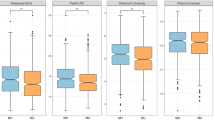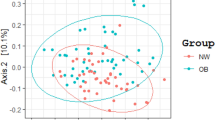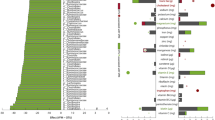Abstract
Objective
Many animal experiments and epidemiological studies have shown that the gut microbiota (GM) plays an important role in the development of obesity, but the specific biological mechanism involved in the pathogenesis of disease remain unknown. We aimed to examine the relationships and functional mechanisms of GM on obesity in peri- and post-menopausal women.
Methods
We recruited 499 Chinese peri- and post-menopausal women and performed comprehensive analyses of the gut microbiome, targeted metabolomics for short-chain fatty acids in serum, and host whole-genome sequencing by various association analysis methods.
Results
Through constrained linear regression analysis, we found that an elevated abundance of Bacteroides fragilis (B. fragilis) was associated with obesity. We also found that serum levels of acetic acid were negatively associated with obesity, and that B. fragilis was negatively associated with serum acetic acid levels by partial Spearman correlation analysis. Mendelian randomization analysis indicated that B. fragilis increases the risk of obesity and may causally down-regulate acetic acid levels.
Conclusions
We found the gut with B. fragilis may accelerate obesity, in part, by suppressing acetic acid levels. Therefore, B. fragilis and acetic acid may represent important therapeutic targets for obesity intervention in peri- and post-menopausal women.
This is a preview of subscription content, access via your institution
Access options
Subscribe to this journal
Receive 12 print issues and online access
$259.00 per year
only $21.58 per issue
Buy this article
- Purchase on Springer Link
- Instant access to full article PDF
Prices may be subject to local taxes which are calculated during checkout
Similar content being viewed by others
Data availability
The datasets generated during and/or analyzed during the current study are available from the corresponding author on reasonable request.
References
Rillamas-Sun E, LaCroix AZ, Waring ME, Kroenke CH, LaMonte MJ, Vitolins MZ, et al. Obesity and late-age survival without major disease or disability in older women. JAMA Intern Med. 2014;174:98–106.
Di Cesare M, Bentham J, Stevens GA, Zhou B, Danaei G, Lu Y, et al. Trends in adult body-mass index in 200 countries from 1975 to 2014: a pooled analysis of 1698 population-based measurement studies with 19.2 million participants. Lancet. 2016;387:1377–96.
Ley CJ, Lees B, Stevenson JC. Sex- and menopause-associated changes in body-fat distribution. Am J Clin Nutr. 1992;55:950–4.
Wells JC. Sexual dimorphism of body composition. Best Pract Res Clin Endocrinol Metab. 2007;21:415–30.
Gibson CJ, Thurston RC, El Khoudary SR, Sutton-Tyrrell K, Matthews KA. Body mass index following natural menopause and hysterectomy with and without bilateral oophorectomy. Int J Obesity. 2013;37:809–13.
Rexrode KM. Emerging risk factors in women. Stroke. 2010;41:S9–11.
Verhaeghe J. Menopause care for obese and diabetic women. Facts Views Vis Obgyn. 2009;1:142–52.
Backhed F, Ding H, Wang T, Hooper LV, Koh GY, Nagy A, et al. The gut microbiota as an environmental factor that regulates fat storage. Proc Natl Acad Sci USA. 2004;101:15718–23.
Cox AJ, West NP, Cripps AW. Obesity, inflammation, and the gut microbiota. Lancet Diabetes Endo. 2015;3:207–15.
Liu RX, Hong J, Xu XQ, Feng Q, Zhang DY, Gu YY, et al. Gut microbiome and serum metabolome alterations in obesity and after weight-loss intervention. Nat Med. 2017;23:859.
Turnbaugh PJ, Ley RE, Mahowald MA, Magrini V, Mardis ER, Gordon JI. An obesity-associated gut microbiome with increased capacity for energy harvest. Nature. 2006;444:1027–31.
Jumpertz R, Le DS, Turnbaugh PJ, Trinidad C, Bogardus C, Gordon JI, et al. Energy-balance studies reveal associations between gut microbes, caloric load, and nutrient absorption in humans. Am J Clin Nutr. 2011;94:58–65.
Canfora EE, Jocken JW, Blaak EE. Short-chain fatty acids in control of body weight and insulin sensitivity. Nat Rev Endocrinol. 2015;11:577–91.
Rios-Covian D, Ruas-Madiedo P, Margolles A, Gueimonde M, de los Reyes-Gavilan CG, Salazar N. Intestinal short chain fatty acids and their link with diet and human health. Front Microbiol. 2016;7:185.
Lumsden MA. The NICE guideline—menopause: diagnosis and management. Climacteric. 2016;19:426–9.
Piercy KL, Troiano RP. Physical activity guidelines for Americans from the US Department of Health and Human Services Cardiovascular Benefits and Recommendations. Circ Cardiovasc Qual Outcomes. 2018;11:e005263.
Chen GC, Arthur R, Iyengar NM, Kamensky V, Xue XN, Wassertheil-Smoller S, et al. Association between regional body fat and cardiovascular disease risk among postmenopausal women with normal body mass index. Eur Heart J. 2019;40:2849.
Tchkonia T, Thomou T, Zhu Y, Karagiannides I, Pothoulakis C, Jensen MD, et al. Mechanisms and metabolic implications of regional differences among fat depots. Cell Metab. 2013;17:644–56.
Vasan SK, Osmond C, Canoy D, Christodoulides C, Neville MJ, Di Gravio C, et al. Comparison of regional fat measurements by dual-energy X-ray absorptiometry and conventional anthropometry and their association with markers of diabetes and cardiovascular disease risk. Int J Obesity. 2018;42:850–7.
Dixon P. VEGAN, a package of R functions for community ecology. J Veg Sci. 2003;14:927–30.
Zhao N, Chen J, Carroll IM, Ringel-Kulka T, Epstein MP, Zhou H, et al. Testing in microbiome-profiling studies with MiRKAT, the microbiome regression-based kernel association test. Am J Hum Genet. 2015;96:797–807.
Jain M, Flynn DF, Prager CM, Hart GM, Devan CM, Ahrestani FS, et al. The importance of rare species: a trait-based assessment of rare species contributions to functional diversity and possible ecosystem function in tall-grass prairies. Ecol Evol. 2014;4:104–12.
Mazloom K, Siddiqi I, Covasa M. Probiotics: how effective are they in the fight against obesity? Nutrients. 2019;11:258.
Shi PX, Zhang AR, Li HZ. Regression analysis for microbiome compositional data. Ann Appl Stat. 2016;10:1019–40.
Cuevas-Sierra A, Ramos-Lopez O, Riezu-Boj JI, Milagro FI, Martinez JA. Diet, gut microbiota, and obesity: links with host genetics and epigenetics and potential applications. Adv Nutr. 2019;10:S17–30.
McAllister EJ, Dhurandhar NV, Keith SW, Aronne LJ, Barger J, Baskin M, et al. Ten putative contributors to the obesity epidemic. Crit Rev Food Sci. 2009;49:868–913.
Koshiba S, Motoike IN, Saigusa D, Inoue J, Aoki Y, Tadaka S, et al. Identification of critical genetic variants associated with metabolic phenotypes of the Japanese population. Commun Biol. 2020;3:662.
Sanna S, van Zuydam NR, Mahajan A, Kurilshikov A, Vila AV, Vosa U, et al. Causal relationships among the gut microbiome, short-chain fatty acids and metabolic diseases. Nat Genet. 2019;51:600.
Tang WHW, Kitai T, Hazen SL. Gut microbiota in cardiovascular health and disease. Circ Res. 2017;120:1183–96.
Lai FY, Nath M, Hamby SE, Thompson JR, Nelson CP, Samani NJ. Adult height and risk of 50 diseases: a combined epidemiological and genetic analysis. BMC Med. 2018;16:1–18.
Aguilar P, Dorador C, Vila I, Sommaruga R. Bacterioplankton composition in tropical high-elevation lakes of the Andean plateau. FEMS Microbiol Ecol. 2018;94:fiy004.
LeBlanc JG, Chain F, Martin R, Bermudez-Humaran LG, Courau S, Langella P. Beneficial effects on host energy metabolism of short-chain fatty acids and vitamins produced by commensal and probiotic bacteria. Microb Cell Fact. 2017;16:1–10.
Turnbaugh PJ, Hamady M, Yatsunenko T, Cantarel BL, Duncan A, Ley RE, et al. A core gut microbiome in obese and lean twins. Nature. 2009;457:480–4.
Larsen OFA, Claassen E. The mechanistic link between health and gut microbiota diversity. Sci Rep. 2018;8:1–5.
Wilson MM, Anderson DE, Bernstein HD. Analysis of the outer membrane proteome and secretome of bacteroides fragilis reveals a multiplicity of secretion mechanisms. PLoS ONE. 2015;10:e0117732.
Wexler HM. Bacteroides: the good, the bad, and the nitty-gritty. Clin Microbiol Rev. 2007;20:593.
Ignacio A, Fernandes MR, Rodrigues VAA, Groppo FC, Cardoso AL, Avila-Campos MJ, et al. Correlation between body mass index and faecal microbiota from children. Clin Microbiol Infec. 2016;22:258.e1–8.
Nagata S, Chiba Y, Wang C, Yamashiro Y. The effects of the Lactobacillus casei strain on obesity in children: a pilot study. Benef Microbes. 2017;8:535–43.
Scheepers LE, Penders J, Mbakwa CA, Thijs C, Mommers M, Arts IC. The intestinal microbiota composition and weight development in children: the KOALA Birth Cohort Study. Int J Obes. 2015;39:16–25.
Morrison DJ, Preston T. Formation of short chain fatty acids by the gut microbiota and their impact on human metabolism. Gut Microbes. 2016;7:189–200.
Zhang XY, Shen DQ, Fang ZW, Jie ZY, Qiu XM, Zhang CF, et al. Human gut microbiota changes reveal the progression of glucose intolerance. PLoS ONE. 2013;8:e71108.
Chambers ES, Viardot A, Psichas A, Morrison DJ, Murphy KG, Zac-Varghese SEK, et al. Effects of targeted delivery of propionate to the human colon on appetite regulation, body weight maintenance and adiposity in overweight adults. Gut. 2015;64:1744–54.
Zhao LP, Zhang F, Ding XY, Wu GJ, Lam YY, Wang XJ, et al. Gut bacteria selectively promoted by dietary fibers alleviate type 2 diabetes. Science. 2018;359:1151.
Frost G, Sleeth ML, Sahuri-Arisoylu M, Lizarbe B, Cerdan S, Brody L, et al. The short-chain fatty acid acetate reduces appetite via a central homeostatic mechanism. Nat Commun. 2014;5:1–11.
Coyte KZ, Rakoff-Nahoum S. Understanding competition and cooperation within the mammalian gut microbiome. Curr Biol. 2019;29:R538–44.
Macfarlane S, Macfarlane GT. Regulation of short-chain fatty acid production. Proc Nutr Soc. 2003;62:67–72.
Nasabian PJ, Inglis JE, Reilly W, Kelly OJ, Ilich JZ. Aging human body: changes in bone, muscle and body fat with consequent changes in nutrient intake. J Endocrinol. 2017;234:R37–51.
Acknowledgements
H-WD was partially supported by grants from the National Institutes of Health [U19AG05537301, R01AR069055, P20GM109036, R01MH104680, R01AG061917, U54MD007595]. H-MX was partially supported by the National Key R&D Program of China (2017YFC1001100 and 2016YFC1201805). JS was partially supported by grants from the Science and Technology Program of Guangzhou, China [201604020007], and the National Natural Science Foundation of China [81770878].
Author information
Authors and Affiliations
Contributions
H-WD designed the study protocol and directed all parts of the project. JS, XL, R-KL and X-ZZ performed clinical diagnosis and recruited subjects. XL, H-ML and B-YL contributed to the data analysis. W-DS conducted data analysis and drafted the first edition of the document. H-WD revised, rewrote/re-structured some sections and finalized the manuscript. H-MX and JS provided support and constructive criticism in the study. JG, H-ML, XL, W-QL, XQ, and B-YL contributed to text revision and discussion.
Corresponding authors
Ethics declarations
Competing interests
The authors declare no competing interests.
Additional information
Publisher’s note Springer Nature remains neutral with regard to jurisdictional claims in published maps and institutional affiliations.
Rights and permissions
Springer Nature or its licensor holds exclusive rights to this article under a publishing agreement with the author(s) or other rightsholder(s); author self-archiving of the accepted manuscript version of this article is solely governed by the terms of such publishing agreement and applicable law.
About this article
Cite this article
Shen, WD., Lin, X., Liu, HM. et al. Gut microbiota accelerates obesity in peri-/post-menopausal women via Bacteroides fragilis and acetic acid. Int J Obes 46, 1918–1924 (2022). https://doi.org/10.1038/s41366-022-01137-9
Received:
Revised:
Accepted:
Published:
Issue Date:
DOI: https://doi.org/10.1038/s41366-022-01137-9
This article is cited by
-
The 100 top-cited articles in menopausal syndrome: a bibliometric analysis
Reproductive Health (2024)
-
Anti-obesity activity of human gut microbiota Bacteroides stercoris KGMB02265
Archives of Microbiology (2024)
-
Glycerol tributylate (Triacylglycerol tributanoate) promoted the liver lipid metabolism by cultivating the intestinal flora of grass carp (Ctenopharyngodon idellus)
Fish Physiology and Biochemistry (2023)
-
Bioactive composition and modulatory effects of Hed-Tean-Rad Mushroom, Macrocybe crassa on gut microbiota
3 Biotech (2022)



